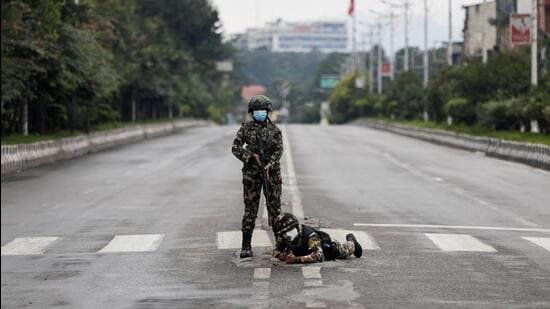A sense of urgency hung over the meeting.
The Qatari prime minister sat across from Hamas’ chief negotiator, Khalil Al-Hayya, under the maroon-and-white flag of the Gulf nation on Monday evening. The two had met many times before in talks that often proved fruitless.
But this time was different.
The United States had just put forward a new ceasefire proposal that could end the nearly two-year war in Gaza. And Sheikh Mohammed bin Abdulrahman bin Jassim Al-Thani was pressuring Al-Hayya to accept.
The discussion wrapped up shortly before 9:30 in the evening, according to a source familiar with the meeting, but the real work was just beginning. After Al-Hayya left, Qatari negotiators got on the phone with their Israeli counterparts to update them on the nascent ceasefire effort.
Unlike most proposals, which came from Qatar and Egypt – the two key mediators able to speak with the US, Israel, and Hamas – this plan came directly from the Trump administration. Qatari negotiators had met with US envoy Steve Witkoff in Paris last week, and President Donald Trump wanted to see progress.
On Sunday, Trump issued what he described as his “last warning” to Hamas to accept the deal. He prematurely claimed Israel had accepted the proposal, even though Israeli officials had only said they were “seriously considering” it.
It fell on Qatar to turn the proposal into an agreement.
The call between the Qatari and Israeli negotiating teams lasted until 5:00 in the morning. Hamas had promised to respond to Qatari negotiators 12 hours later.
Israel had other plans.
Before time was up, Israeli missiles slammed into a residential building in Doha in which Israeli intelligence believed Hamas’ senior leaders had gathered.
CNN spoke with more than a dozen officials and sources in Israel, Qatar and the US to piece together a timeline of the critical moments around an operation that may well reshape the region. In a single attack, US credibility across the Middle East was put on the line. Qatar and its neighbors were outraged, the US was surprised, and Israel was unapologetic.
For more than two months, Israel had been planning a military operation that was both daring and brazen: a strike against senior Hamas leaders in Doha. The city had become a vital hub for talks to free the hostages and end the war – and one frequently visited by top Israeli officials.
Soon after the October 7, 2023, attacks, Israel made clear that it would target Hamas’ leadership in Gaza and abroad. International borders were no protection for the militant group. But those attacks and operations were only carried out in enemy states, such as the killing of Ismail Haniyeh in Iran and of Saleh al-Arouri in Lebanon.
A strike in Qatar would be an attack against a sovereign nation that has played a crucial mediating role in ceasefire talks and hosts a massive US military presence. Qatar was also home to Hamas’ senior leaders, including Khalil Al-Hayya. The group’s chief negotiator had lived in Doha for years.

Meanwhile, Qatar’s relationship with the US has steadily grown. The Pentagon has employed Al-Udeid Air Base as its largest facility in the region for more than two decades. In 2022, former President Joe Biden declared the Gulf state a major non-NATO ally. Last year, US and Qatari sources told CNN that the country had agreed to kick Hamas leaders out, but little came of the promise, with several of the group’s leaders remaining in Doha.
In May, Trump became the first sitting US president to visit the Gulf state, promising Qatar that “we are going to protect this country.” Doha pledged a $1.2 trillion economic commitment to the US on Trump’s short stay in the country and gifted his government a jumbo jet to use as Air Force One.
Israel has its own complex relationship with Qatar. The two Middle East nations do not have formal ties, but for years, officials have traveled back and forth regularly. Qatar established low-level diplomatic relations with Israel in 1996 but closed the Israeli trade office in Doha in 2000. Relations grew markedly in 2018, when Prime Minister Benjamin Netanyahu approved the transfer of hundreds of millions of dollars from Qatar to Gaza. The money, carried in suitcases of cash during frequent visits by Doha’s envoy to the Hamas-ruled territory, was intended for civil servant salaries, families in need, and utilities.
But the relations have deteriorated significantly since the start of the war in Gaza, with Israeli officials voicing growing anger at Qatar, accusing the government of harboring Hamas and not putting enough pressure on it to agree to a ceasefire.
The Israeli government concluded that striking in Qatar was worth the risk. In recent weeks, it accelerated planning for the complex, long-range mission. As the Israel Defense Forces (IDF) pressed ahead with its assault on Gaza City, the Israeli Air Force prepared for what would be the first-ever Israeli strike on a Gulf Arab nation.
It came down to a question of when.

IDF Chief of Staff Lt. Gen. Eyal Zamir and Mossad chief David Barnea, who had been a regular in Doha over the past two years, questioned the timing of the operation, which would come just days after the US put forward its new ceasefire proposal.
But recently, the two have been sidelined on some of Israel’s key security decisions as Netanyahu prioritizes the demands of his far-right coalition partners.
Zamir had opposed the government’s plan to take over and occupy Gaza City, warning that it would put soldiers and the remaining 48 hostages at risk. His concerns were brushed aside. In February, Barnea was replaced as the head of Israel’s negotiating team by Netanyahu confidant Ron Dermer.
Now Netanyahu was once again pushing forward over the reservations of two of his top security officials.
The operation received preliminary approval on Monday, according to an Israeli official. The Shin Bet, Israel’s internal security agency – which has the primary responsibility for monitoring Hamas, had intelligence that senior Hamas officials were convening in Doha to discuss the exact proposal the US was advancing. It’s unclear if it was the same meeting in which the Qatari prime minister pressed Hamas to accept the deal.
The key target was Al-Hayya. Israel delayed the operation by a day to firm up identification. Final approval came just hours before the strike.
On Tuesday afternoon, more than 10 Israeli fighter jets launched into the skies over the Middle East to carry out the attack. The IDF has not publicly stated what aircraft or weapons were used in the operation, but Israel’s F-35I, F-15 and F-16 fighter jets were used extensively during the 12-day conflict with Iran, a similar distance to an operation in Qatar. The jets, obtained from the United States, had proven their mettle, operating in an environment saturated with enemy radars.
Only now, they were American radars scanning the skies.
The US maintains a massive military presence at Al-Udeid Air Base just outside Doha. The sprawling facility is the nucleus for much of the US Air Force’s operations in the Middle East, and US Central Command, which governs American operations in the region, would view any unidentified incoming aircraft as a potential threat. Qatar also boasts one of the most advanced early warning radar systems in the region, coupled with Patriot air defense missile system.
Israel had to inform the US without jeopardizing the operation. Too much advance warning would give the Trump administration time to tell Qatar, which could in turn inform Hamas of the impending strike.

As Israeli fighter jets cut across the skies to their target, Netanyahu hunkered down in the Shin Bet’s Special Operations Command Center in central Israel. In a picture released by the Shin Bet, Defense Minister Israel Katz and Netanyahu’s chief of staff are seen peering over his shoulders.
At 3:46 in the afternoon, more than 10 munitions struck a residential building in central Doha in what the IDF called a “precise strike.”
Israel intentionally waited until the last minute to notify the Trump administration about the strike, knowing the US would immediately inform Qatar about the incoming attack. But it’s unclear exactly how the notification proceeded.
Instead of a direct call between the two leaders – which would not have been out of the ordinary between Netanyahu and Trump – the critical notice about an unprecedented attack on a key US ally took a circuitous route.
The top US general, Chairman of the Joint Chiefs of Staff Gen. Dan Caine, told Trump about the operation. Trump informed US envoy Steve Witkoff, who then notified the Qataris.
By the time the Qataris got the call, the strike had already taken place 10 minutes earlier.
Israel was quick to take full responsibility for the attack in an attempt to distance the US from the mission. Netanyahu said that it was a “wholly independent Israeli operation.” The statement was made at the request of the US.
Qatar’s prime minister, who had pressed Hamas to accept the proposal a day earlier, was furious, calling the attack “state terrorism.”
In an exclusive interview with CNN, Al-Thani said, “If we look at the pattern of Netanyahu’s actions since October 7, since the war started, it’s been in a very systematic way trying to undermine any chance of stability, any chance of peace, and any chance of retrieving his own hostages.”

For Israel, the bigger problem was the US. Trump said he was “very unhappy about every aspect” of the strike. Some of Trump’s advisers were angry about the decision to carry out the attack, and many were frustrated that they weren’t able to weigh in or warn the Qataris.
In the hours after the strike, Netanyahu talked to Trump on two separate phone calls. “The conversations were very good,” one Israeli official said.
White House press secretary Karoline Leavitt did not condemn the targeting of Hamas leaders abroad, even as she criticized the operation.
“Unilaterally bombing inside Qatar, a sovereign nation and close ally of the United States that is working very hard in bravely taking risks with us to broker peace, does not advance Israel or America’s goals,” Leavitt said on Tuesday.
Israel portrayed the attack as a step that could bring the end of the war closer, the same claim it made after killing Hamas leaders Yahya Sinwar and his younger brother Mohammed Sinwar in Gaza. Yet the conflict is now less than a month from its two-year mark. Between US frustration and Qatar saying that Netanyahu “killed any hope for those hostages,” the negotiations effort suddenly has no clear way forward.
But for now, Israel has another major problem.
Hamas said on Tuesday night that Israel failed to assassinate Al-Hayya and the negotiations delegation. Instead, five lower-level Hamas members were killed in the strike, as well as a Qatari security guard.
By Wednesday morning, doubts were growing in Israel about the success of the operation. Within hours, the doubts had grown into pessimism.
The strike was not so precise after all.







